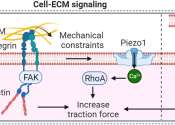Mechanical constraints guide spatial pattern of glioblastoma cancer stem cells
A recent study has discovered the function of mechanical constraints in glioblastoma. This study led by Prof. Chen from the Department of Biomedical Engineering at New York University explored the underlying mechanotransductive ...
Apr 2, 2024
0
0









